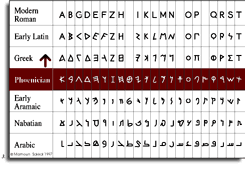The earliest-known alphabet to mankind was the North Semitic, which developed around 1700 B.C. in Palestine and Syria. It consisted of 22 consonant letters. The Arabic, Hebrew, and Phoenician alphabets were based on this model. Then, around 1000 B.C., the Phoenician alphabet was itself used as a model by the Greeks, who added letters for vowels. Greek in turn became the model for Etruscan (c. 800 B.C.), whence came the letters of the ancient Roman alphabet, and ultimately all Western alphabets.

The North Arabic script, which eventually prevailed and became the Arabic script of the Quran, relates most substantially and directly to the Nabatian script, which was derived from the Aramaic script. Old Aramaic, the language of Jesus and the Apostles, dates from the 2nd millennium B.C., and some dialects of which are still spoken by tiny groups in the Middle East.
Arabic script still shares with Aramaic the names of the alphabet letters (Alef, Jeem, Dal, Zai, Sheen, etc.); similar graphic representation for phonetically similar letters (Sad and Dad, Ta and Tha, etc.); connections of letters in the same word and several forms of each letter depending on its location in the word, except for letters that cannot be connected to the letters which come after them (Alef, Dal, Raa, Waw). The Arabic alphabet contains 18 letter shapes, by adding one, two, or three dots to letters with similar phonetic characteristics a total of 28 letters is obtained. These contain three long vowels, while diacritics can be added to indicate short vowels.

